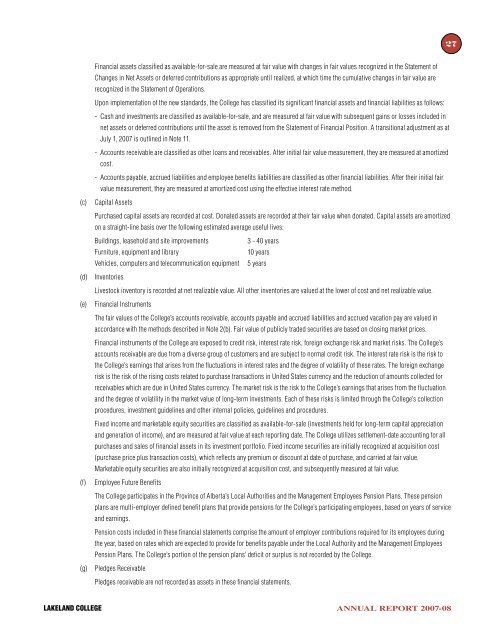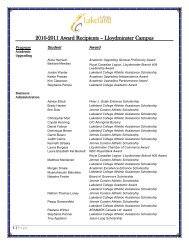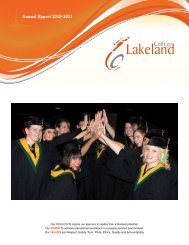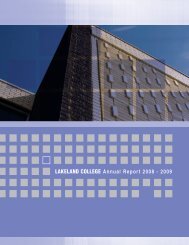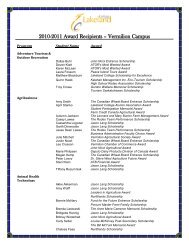LAKELAND COLLEGE
LAKELAND COLLEGE
LAKELAND COLLEGE
- No tags were found...
You also want an ePaper? Increase the reach of your titles
YUMPU automatically turns print PDFs into web optimized ePapers that Google loves.
27<br />
(c)<br />
(d)<br />
(e)<br />
(f)<br />
(g)<br />
Financial assets classified as available-for-sale are measured at fair value with changes in fair values recognized in the Statement of<br />
Changes in Net Assets or deferred contributions as appropriate until realized, at which time the cumulative changes in fair value are<br />
recognized in the Statement of Operations.<br />
Upon implementation of the new standards, the College has classified its significant financial assets and financial liabilities as follows:<br />
- Cash and investments are classified as available-for-sale, and are measured at fair value with subsequent gains or losses included in<br />
net assets or deferred contributions until the asset is removed from the Statement of Financial Position. A transitional adjustment as at<br />
July 1, 2007 is outlined in Note 11.<br />
- Accounts receivable are classified as other loans and receivables. After initial fair value measurement, they are measured at amortized<br />
cost.<br />
- Accounts payable, accrued liabilities and employee benefits liabilities are classified as other financial liabilities. After their initial fair<br />
value measurement, they are measured at amortized cost using the effective interest rate method.<br />
Capital Assets<br />
Purchased capital assets are recorded at cost. Donated assets are recorded at their fair value when donated. Capital assets are amortized<br />
on a straight-line basis over the following estimated average useful lives:<br />
Buildings, leasehold and site improvements<br />
3 - 40 years<br />
Furniture, equipment and library<br />
10 years<br />
Vehicles, computers and telecommunication equipment 5 years<br />
Inventories<br />
Livestock inventory is recorded at net realizable value. All other inventories are valued at the lower of cost and net realizable value.<br />
Financial Instruments<br />
The fair values of the College’s accounts receivable, accounts payable and accrued liabilities and accrued vacation pay are valued in<br />
accordance with the methods described in Note 2(b). Fair value of publicly traded securities are based on closing market prices.<br />
Financial instruments of the College are exposed to credit risk, interest rate risk, foreign exchange risk and market risks. The College’s<br />
accounts receivable are due from a diverse group of customers and are subject to normal credit risk. The interest rate risk is the risk to<br />
the College’s earnings that arises from the fluctuations in interest rates and the degree of volatility of these rates. The foreign exchange<br />
risk is the risk of the rising costs related to purchase transactions in United States currency and the reduction of amounts collected for<br />
receivables which are due in United States currency. The market risk is the risk to the College’s earnings that arises from the fluctuation<br />
and the degree of volatility in the market value of long-term investments. Each of these risks is limited through the College’s collection<br />
procedures, investment guidelines and other internal policies, guidelines and procedures.<br />
Fixed income and marketable equity securities are classified as available-for-sale (investments held for long-term capital appreciation<br />
and generation of income), and are measured at fair value at each reporting date. The College utilizes settlement-date accounting for all<br />
purchases and sales of financial assets in its investment portfolio. Fixed income securities are initially recognized at acquisition cost<br />
(purchase price plus transaction costs), which reflects any premium or discount at date of purchase, and carried at fair value.<br />
Marketable equity securities are also initially recognized at acquisition cost, and subsequently measured at fair value.<br />
Employee Future Benefits<br />
The College participates in the Province of Alberta’s Local Authorities and the Management Employees Pension Plans. These pension<br />
plans are multi-employer defined benefit plans that provide pensions for the College’s participating employees, based on years of service<br />
and earnings.<br />
Pension costs included in these financial statements comprise the amount of employer contributions required for its employees during<br />
the year, based on rates which are expected to provide for benefits payable under the Local Authority and the Management Employees<br />
Pension Plans. The College’s portion of the pension plans’ deficit or surplus is not recorded by the College.<br />
Pledges Receivable<br />
Pledges receivable are not recorded as assets in these financial statements.<br />
<strong>LAKELAND</strong> <strong>COLLEGE</strong><br />
ANNUAL REPORT 2007-08


